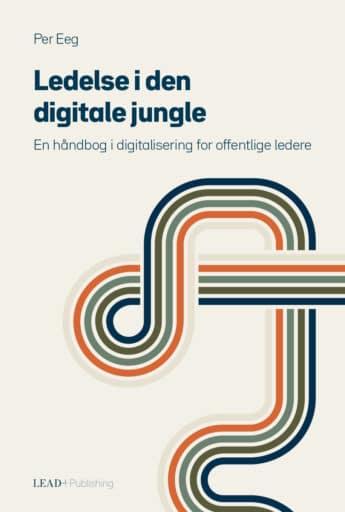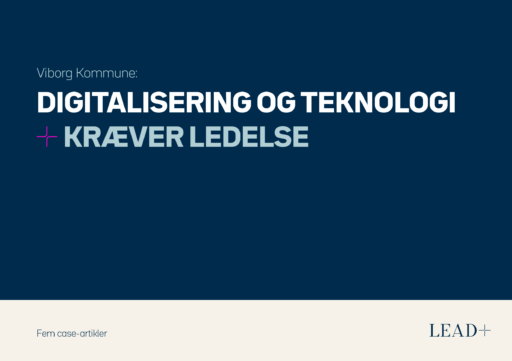What is welfare? Roughly speaking, it's basically getting more tomorrow than I get today. Expectations of the public sector are constantly rising, and we expect what we get from the public sector to match what we get elsewhere in society. On average, public consumption per capita has only increased by 0.11 percent annually from 2010 to 2018. In comparison, the increase in private consumption of 0.81 percent has been more than seven times as high4. This creates dissatisfaction with the level of service in the public sector and accelerates pressure for the public sector to deliver more. This calls for executive management to bring a wide range of digital solutions into play to try and increase productivity.
At the same time, management will have to navigate the cross-pressure that arises when the demand for more welfare meets another macro trend: Do it yourself. Roughly speaking, the main line here is that virtually all citizens are being told that they must create welfare themselves. Co-creation and co-production are increasingly integrated into the municipality's core operations in all major welfare areas. This is met with digital self-service solutions and automated processes, all of which make citizens their own case manager. In addition, there is a cultural trend that digital natives are getting used to the fact that it is not from professionals or public organizations that you learn something or get what creates value. If there's something you can't figure out, you learn it yourself via YouTube, and if you need a problem solved, you do it through digital social networks.
Traditionally, wellbeing is largely defined as something that is linked to having a large number of skilled professionals. This will not go away, but it is increasingly being supplemented with another perspective that goes something like this: welfare is the best possible technology everywhere. It used to be welfare that there were caregivers and nurses present to turn the elderly and care for their bedsores - now it's welfare that we have intelligent beds that distribute pressure before the bedsores appear.
In principle, by combining a wide range of data, it is possible to predict what needs and possible problems a citizen will have in the future and, based on this, intervene or offer services. For example, we can predict who will have which health problems and who in this group will respond most positively to a health-promoting intervention. At the same time, individuals increasingly expect individualized service. This increases the focus across all disciplines on delivering data-driven, predictive and individualized welfare. As the digital maturity of citizens and politicians increases, there will also be a growing demand to use resources in a much more targeted way and where data and algorithms can predict that they will have the highest degree of impact.
All of the above perspectives assume that the municipality and the digital are central to wellbeing, but what if wellbeing is not something I get from the municipality, but from relationships? Happiness research suggests that these analog things are the key ingredients of a happy life:
- Being allowed to be something for someone
- That there is someone who cares about me
- Being part of a community
- When talking about digital transformation, it's crucial to consider what digital can't do.
Understand digital transformation and the leadership task
There's a lot of confusion and bullshit bingo about anything that rhymes with digital. The more real reason why digital can be difficult to grasp is this: what digital is, as well as the organizational focus and purpose of digital, has shifted over time. When navigating as a senior leader, it's therefore helpful to keep an eye on three waves of development:
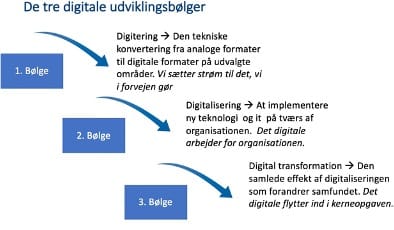
Wave 1 - Digitization: First, it's about the technical process of taking something that's analog and making it digital. The melody on the LP is converted into an MP3 file, and the paper form is powered up so that the citizen checks off online instead. In nerdy circles, the conversion from analog to digital is called 'Digitization' Across the Danish public sector, it becomes a key management focus from the late 90s, driven by the opportunity for savings, smoother administrative processes and up-to-date solutions for citizens. The quick wins are realized and the mood in the boardroom is optimistic.
2. Wave - Digitization: As the analogue becomes digital, it is increasingly possible to build more comprehensive system solutions that bring together communication, data and create new interfaces in the meeting between the citizen and the public organization. Forældreintra, electronic patient records, e-boks, etc. are just a few examples. At the same time, major transformations are taking place in the private sector, where online shopping, social media and pervasive digitization of business processes are creating new business models. Now, the meaning of digitalization is expanding to include the organizational process of developing and implementing new technology, IT, etc. across the organization to create new and improved services or benefits. In other words, the organizational process of making digital work for the organization. At the top of public organizations, this is often a turbulent experience. The destination looks appealing, but the journey rarely goes as planned, and the bill is always bigger than expected. Further down in the organization, the managerial focus turns to two main tasks: A) You need to keep operations running while implementing something new that often doesn't work optimally; and B) You need to develop employee skills and create commitment to the new.
3. Wave - Digital transformation: Here, the focus is not on new technologies, IT etc. but on the radical change in society that occurs as a result of actors at all levels digitizing their processes, business models or ways of acting in the world. The Lime scooter that appeared overnight in Danish cities is a good example of what happens when smartphones, online payment solutions, the trend of renting rather than owning, a focus on green mobility, advanced GPS and platform hiring meet with capital injections from Silicon Valley. In other words: The whole becomes more than the sum of its parts. When almost everything is digitized, it creates both synergies and unpredictable effects that we cannot control, but must act on and navigate. On the other hand, it also means that digital is moving into the core task across all areas that the public organization deals with. At all levels of the public organization, the task becomes, on the one hand, to act in what you can't control and, on the other hand, to use digital everywhere possible as an integral part of the core task. It is fundamentally about ensuring public value creation and actively counteracting value erosion - it is the task of the executive board to ensure that this balance is in the plus side.
In these years, the focus is particularly on the 3rd wave, but that doesn't mean that the previous two waves are irrelevant or a thing of the past. On the contrary, the complexity lies in the following:
- We have "technological debt" and other hassles from the first or second wave that we have to deal with as the third wave rolls in.
- Our skills and digital mindset are shaped by the first two waves, but the third wave requires something new, and we'll fail if we just do business as usual.
In the following, we explore some of the new things that digital transformation requires of us and our organizations.
JOIN OUR COURSE
Build wellbeing and trust despite the distance
The "Managing Virtual and Hybrid Work Communities" course gives you the essential tools to increase productivity and well-being through remote management.
This is a course for those who work in management and want to know how to achieve strategic goals as an individual or organization through virtual collaboration.
The future is here now - Welfare society in digital transformation
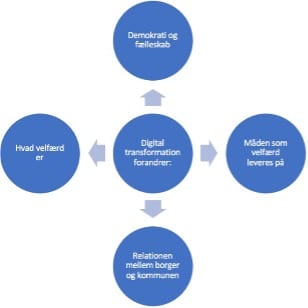
Democracy and community in digital transformation

Relationship between the citizen and the public in digital transformation
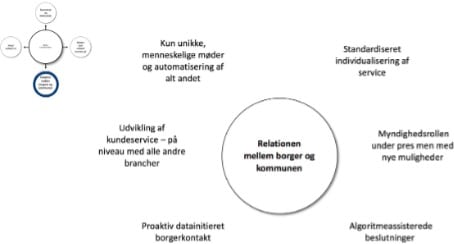
- Through digital interfaces.
- Unique encounters with professionals wherever human contact is needed.
- From choosing between a limited number of products based on company-driven information to choosing between an infinite number of products based on open comparison driven by customers.
- From 9am-4pm access five days a week - often with a wait - to 24/7 access with no wait.
- From the company deciding where and how the interaction happens, to the customer controlling where and how the interaction happens.
- From opaque black-box processes where only the company knows where the order is, to transparent processes where the customer can see live where the case/order is in the process.
The way welfare is delivered in digital transformation
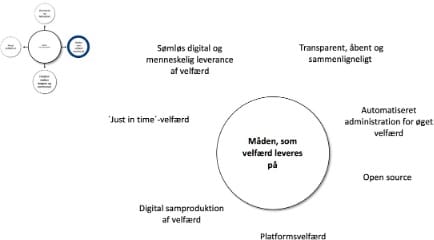
What welfare is in digital transformation

What is welfare? Roughly speaking, it's basically getting more tomorrow than I get today. Expectations of the public sector are constantly rising, and we expect what we get from the public sector to match what we get elsewhere in society. On average, public consumption per capita has only increased by 0.11 percent annually from 2010 to 2018. In comparison, the increase in private consumption of 0.81 percent has been more than seven times as high4. This creates dissatisfaction with the level of service in the public sector and accelerates pressure for the public sector to deliver more. This calls for executive management to bring a wide range of digital solutions into play to try and increase productivity.
At the same time, management will have to navigate the cross-pressure that arises when the demand for more welfare meets another macro trend: Do it yourself. Roughly speaking, the main line here is that virtually all citizens are being told that they must create welfare themselves. Co-creation and co-production are increasingly integrated into the municipality's core operations in all major welfare areas. This is met with digital self-service solutions and automated processes, all of which make citizens their own case manager. In addition, there is a cultural trend that digital natives are getting used to the fact that it is not from professionals or public organizations that you learn something or get what creates value. If there's something you can't figure out, you learn it yourself via YouTube, and if you need a problem solved, you do it through digital social networks.
Traditionally, wellbeing is largely defined as something that is linked to having a large number of skilled professionals. This will not go away, but it is increasingly being supplemented with another perspective that goes something like this: welfare is the best possible technology everywhere. It used to be welfare that there were caregivers and nurses present to turn the elderly and care for their bedsores - now it's welfare that we have intelligent beds that distribute pressure before the bedsores appear.
In principle, by combining a wide range of data, it is possible to predict what needs and possible problems a citizen will have in the future and, based on this, intervene or offer services. For example, we can predict who will have which health problems and who in this group will respond most positively to a health-promoting intervention. At the same time, individuals increasingly expect individualized service. This increases the focus across all disciplines on delivering data-driven, predictive and individualized welfare. As the digital maturity of citizens and politicians increases, there will also be a growing demand to use resources in a much more targeted way and where data and algorithms can predict that they will have the highest degree of impact.
All of the above perspectives assume that the municipality and the digital are central to wellbeing, but what if wellbeing is not something I get from the municipality, but from relationships? Happiness research suggests that these analog things are the key ingredients of a happy life:
- Being allowed to be something for someone
- That there is someone who cares about me
- Being part of a community
- When talking about digital transformation, it's crucial to consider what digital can't do.
The future is here now
As a public sector leader, you're at the helm of a large societal organization in the midst of a digital revolution that is transforming and changing the basic conditions for public sector leadership. The consequences of the technological development are colossal and call for the entire organization to gear itself to be able to act in a time of digital transformation.
The development calls for strong and new leadership in the Executive Board, because it is the Executive Board - not the IT department - that must engage and get the entire organization on board. It is not about technology or management of digitalization, but rather about how we together ensure that the public organization, together with citizens and politicians, contribute to creating the society and welfare that the community wants in a new era with digital premises. The question is not so much what we can do, but what we want to do. It is important to understand the new technologies, but it is even more important to be able to set a direction based on ethical and democratic considerations. The stakes are high, as digital transformation has the potential to erode the foundations of welfare and destabilize communities.


